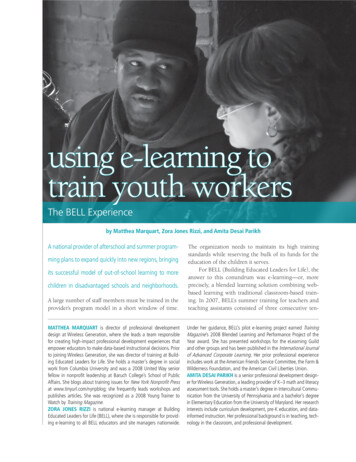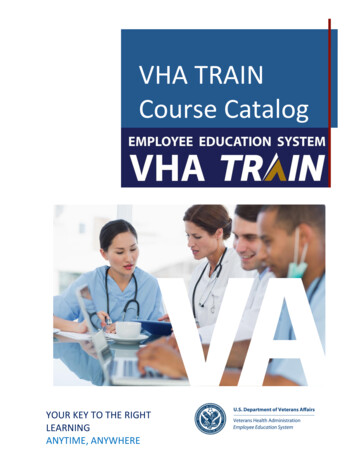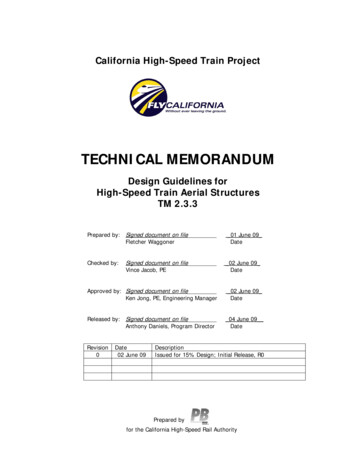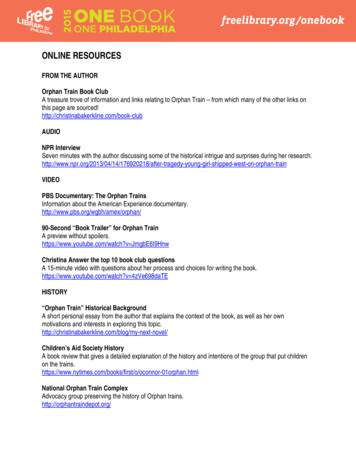
Transcription
using e-learning totrain youth workersThe BELL Experienceby Matthea Marquart, Zora Jones Rizzi, and Amita Desai ParikhA national provider of afterschool and summer program-A large number of staff members must be trained in theprovider’s program model in a short window of time.The organization needs to maintain its high trainingstandards while reserving the bulk of its funds for theeducation of the children it serves.For BELL (Building Educated Leaders for Life), theanswer to this conundrum was e-learning—or, moreprecisely, a blended learning solution combining webbased learning with traditional classroom-based training. In 2007, BELL’s summer training for teachers andteaching assistants consisted of three consecutive ten-Matthea Marquart is director of professional developmentdesign at Wireless Generation, where she leads a team responsiblefor creating high-impact professional development experiences thatempower educators to make data-based instructional decisions. Priorto joining Wireless Generation, she was director of training at Building Educated Leaders for Life. She holds a master’s degree in socialwork from Columbia University and was a 2008 United Way seniorfellow in nonprofit leadership at Baruch College’s School of PublicAffairs. She blogs about training issues for New York Nonprofit Pressat www.tinyurl.com/nynpblog; she frequently leads workshops andpublishes articles. She was recognized as a 2008 Young Trainer toWatch by Training Magazine.Zora Jones Rizzi is national e-learning manager at BuildingEducated Leaders for Life (BELL), where she is responsible for providing e-learning to all BELL educators and site managers nationwide.Under her guidance, BELL’s pilot e-learning project earned TrainingMagazine’s 2008 Blended Learning and Performance Project of theYear award. She has presented workshops for the eLearning Guildand other groups and has been published in the International Journalof Advanced Corporate Learning. Her prior professional experienceincludes work at the American Friends Service Committee, the Farm &Wilderness Foundation, and the American Civil Liberties Union.Amita Desai Parikh is a senior professional development designer for Wireless Generation, a leading provider of K–3 math and literacyassessment tools. She holds a master’s degree in Intercultural Communication from the University of Pennsylvania and a bachelor’s degreein Elementary Education from the University of Maryland. Her researchinterests include curriculum development, pre-K education, and datainformed instruction. Her professional background is in teaching, technology in the classroom, and professional development.ming plans to expand quickly into new regions, bringingits successful model of out-of-school learning to morechildren in disadvantaged schools and neighborhoods.
hour days of classroom training. That summer, BELLserved three regions: Baltimore, Boston, and New YorkCity. In the summer of 2008, BELL expanded to two additional cities: Detroit and Springfield, Massachusetts.The organization trained over 800 instructional staff andtheir managers in all five regions using the new blendedtraining format.BELL had three goals in launching the e-learningprogram (Marquart, 2008): To improve outcomes for the children served byBELL—called scholars—by providing world-class standardized training to the staff so that they could providethe highest quality tutoring possible. To cut the cost of training so that a higher percentageof BELL funds could be directed toward scholars. To enable BELL to expand quickly to new regions orto partnerships so that as many children as possiblecould benefit. Nimble training that could serve a rapidly growing number of staff in a number of regionswas key to this expansion.The pilot met all of its goals, resulting in strong outcomes for BELL scholars served by staff trained in the newformat, a reduction in training costs to roughly one-thirdof the cost of classroom-based training, and a smoothtraining experience for staff in the two new BELL regions.Why E-learning?Founded in 1992, BELL is a rapidly growing nonprofit organization that provides summer and afterschool tutoringin order to enhance the educational achievements, selfesteem, and life opportunities of elementary school children in low-income, urban communities. BELL servedover 7,000 scholars in the 2007–2008 academic year andover 4,000 scholars in five cities in the summer of 2008.One key to BELL’s growth is its strong training programfor both the instructors who work directly with scholarsand the site managers of the tutoring locations. BecauseBELL training is standardized, the organization can growinto new regions with confidence that the new sites willbe equipped to implement the program model even whenstaff have no prior experience working with BELL.Prior to 2008, BELL’s training was conducted exclusively in a classroom-based format. BELL’s four trainingdepartment staff traveled to manage three-day classroomtraining events in each region. This training configuration was a potential bottleneck in BELL’s plans for aggressive expansion. Therefore, the organization’s boardand senior management charged the training team withdeveloping an e-learning program for site instructors andMarquart, Rizzi, & Parikh managers. By reducing the amount of classroom time,the training team could become more nimble and efficient in support of BELL’s strategic goals.As an initial step, BELL needed to decide what formof e-learning to develop. E-learning comes in manyconstantly changing forms; the American Society forTraining and Development (2009) continually updatesits E-learning Glossary webpage. Though e-learningcan include such modes as, for instance, online classes,digital collaboration, podcasts, and information distributed via CD-ROM, BELL chose to develop web-basedasynchronous e-learning modules. These are stand-alonelearning content and activities that individuals completeon their own, without the guidance of a human facilitator. Completion of the online modules is a prerequisite toclassroom training. BELL’s staff training is thus an example of a blended learning solution: It combines e-learning and classroom-based training. For its site managers,BELL offers synchronous (“real-time”) webinars usingconference calling and web conferencing. The blendede-learning we discuss in this article is for instructionalstaff as well as site managers.Initial ChallengesIn developing its e-learning program, BELL faced a number of challenges that are relevant to any afterschool program considering e-learning, including unknown computer technology, a wide variety of learner expertise andcomputer skill levels, and other challenges that seem tobe inherent in e-learning.Unknown TechnologyBecause administering computer technology is not central to BELL’s mission, BELL did not provide computerlabs or computer technology for staff. Staff memberscompleted the e-learning on computers in their homes,Figure 1. BELL e-learning home pageUsing E-learning to Train Youth Workers29
Figure 2. Educators’ use of social networking websitesat libraries, at school computer labs, and in other people’shomes. The e-learning therefore needed to run on almostany computer and had to be useable even on a dial-upInternet connection. BELL could not assume that userswould have expensive graphics cards, video cards, or avariety of software, so the e-learning could not includea lot of animation or other features that draw heavilyon computer resources. In fact, learners might not evenhave CD drives or the ability to install new software oncomputers that did not belong to them. The e-learningthus needed to be web-based.Learners’ Familiarity and Comfort with TechnologyIn addition to the normal variety of adult learning stylesand needs, BELL was aware that staff using the e-learning had a wide range of experience with education andwith computer technology. For example, while BELL’steaching assistants are frequently college students withlimited classroom teaching experience, the teachers areoften experienced educators with graduate degrees. Yetbecause elementary school teaching does not usually require daily use of a computer, many BELL teachers havelimited experience with computers. At the other endof the scale, many teaching assistants grew up playingvideo games and are inseparable from their mobile devices. Even among teachers, there is often a split betweennewly certified teachers, who are familiar with the latesteducational theories and may have taken an online classin graduate school, and veteran teachers, who have decades of practical teaching experience but may not haveused computers at all when they were in school. Thesedivides meant that the e-learning needed to include detailed directions to help learners who were new to computers, but it needed to do so in a manner that would notfrustrate digital natives.Recent research has shown that barriers to teachers’use of computers and the Internet are falling. School-basededucators, at least, are already using online tools in boththeir professional and personal lives. For example, a recentsurvey of 1,000 educators (edWeb.net, MCH Discover, &mms Education, 2009) found that 61 percent of themwere members of social networking websites as shownin Figure 2. A survey by Teacher Magazine (2009) foundthat 62 percent of teachers use the Internet to get teachingideas at least once a week, as illustrated in Figure 3.Teachers who participate in online learning may findthemselves participating more fully than when they attendtraditional professional development sessions. One reasonmay be that they like the anonymity of the online world,where they may feel they can be more open about their30 Afterschool Matters Are you a member of a Social Networking rariansTeachersYesPrincipalsNoN 979Social Networking sites include general sites (Facebook, My Space, etc.); professional sites (LinkedIn),educational sites (We are Teachers, edWeb.net, Classroom 2.0, etc.).Figure 3. Teachers’ use of the Internet for teaching resourcesHow often have you used an internet resourceto get teaching ideas?2% 2%Everyday or almosteveryday (27%)11%27%Once or twice a week (35%)Once or twice a month (23%)23%A few times a year (11%)Less than a few times a year (2%)35%Never (2%)www.teachermagazine.orgconcerns and frustrations and can talk freely about whatthey aren’t doing as well as they should. As Chris Dede, aprofessor of learning technology at the Harvard GraduateSchool of Education, put it in an interview, “The onlineformat provides a layer of distance that helps people feelmore willing to share things that are a little bit risky thanthey might in a face-to-face environment” (Rebora, 2009,p. 8). Teachers may also enjoy sharing professional knowledge and communicating with colleagues.Inherent ChallengesBELL also needed to tackle, from the outset, several challenges that are inherent in the model of e-learning theorganization chose. For instance, since learners were tocomplete the e-learning on their own time, BELL neededto build in accountability for learning the content. Usershad to log in with a username and password, and thenthey had to complete all of the activities in the e-learning.The activities were not considered complete until everyquestion was answered correctly and every possible action, such as viewing a video or posting to a discussionSpecial Issue April 2010
forum, was taken. The e-learning system tracked thelearners’ actions, and the training department reportedon learners’ progress to their site managers, the regionaldirectors, the staff recruiters, and senior management.When staff fell behind, they received email remindersand phone calls. The fact that the e-learning was cappedby a classroom segment deterred potential cheaters withthe knowledge that they would be held accountable, inperson, for meeting the learning objectives.E-learning inherently has the potential to be isolating for learners, de-motivating, and dull. BELL needed tobuild in balances against these challenges. For instance,as outlined below, the learning was designed to be interactive and motivating whenever possible.As with any training program, BELL’s goal was to increase program quality by providing a superior trainingexperience. Every year, BELL scholars have strong outcomes. The dramatic change in staff training was a potential risk to program quality. Staff needed to be as wellor better prepared by the new format as they had been inprevious years.Another challenge is inherent whenever organizations implement change: staff resistance. BELL’s previousclassroom training was highly interactive and engaging.BELL summer staff are trained each year so that they canstart powerfully and make every program day count.Thus, many staff were familiar with the previous classroom training, and some were not pleased to see classroom time cut by two-thirds to be replaced by e-learning.BELL’s communications with staff about the e-learningprogram had to persuade staff of its value and emphasizethat it was mandatory.BELL’s E-learning ProgramIn response to the e-learning project’s goals and challenges, BELL created an e-learning program that led intothe classroom training. The e-learning introduced BELL’sprogram, policies, and curricula. It was structured in 13modules that provided information and then challengedlearners to apply the learning.Building the E-learning SiteBELL began the process of building its e-learning by going through a request for proposals (RFP) process. Indrafting the RFP and reviewing it with senior managers,the training team clarified the e-learning project’s objectives and laid out expectations regarding interactivity,technology, and look and feel, so that the organizationwas on the same page about what the e-learning projectneeded to accomplish.Marquart, Rizzi, & Parikh Over two dozen e-learning vendors from around theworld responded to the RFP; some had been invited torespond due to their reputation in the field while others saw the RFP on industry discussion boards. Finalistswere invited to do in-person presentations for a crossfunctional committee representing BELL’s management,finance, technology, and training teams. After the committee selected a vendor, a rigorous background checkhad to be conducted. Because the e-learning field is relatively new and volatile, BELL needed to be confident thatits e-learning investment would not be not lost.Once the contract was awarded, the design phasekicked off with a week of meetings for creating detaileduser profiles, running focus groups, brainstorming potential designs, exploring ideas, introducing the potentialand limitations of particular e-learning design tools, laying out project expectations, and discussing work andcommunication styles among the team members whowould be working on the fast-paced project. Feedbackfrom instructional staff, site managers, senior managers,trainers, and e-learning experts helped determine whichinformation should be emphasized. Focus groups withinstructional staff provided insight into the learners’needs and helped guide decision making. For example,younger instructional staff confessed that they wouldbe tempted to get through the e-learning as quickly aspossible, even though they actually wanted to learn thecontent; this led to the decision to lock the “next” buttonon slides until questions were answered correctly. In another example, managers emphasized that they wantedthe e-learning to maintain the classroom training’s focuson BELL’s mission and values; this led to the decision tohave learners memorize BELL’s mission early on and toinfuse the mission throughout the e-learning.After the project kicked off, internal staff collaborated daily with the e-learning vendor, Kineo, on scripting, selecting images, planning, and reviewing designs.With the tight deadline and ambitious goals, frequentcommunication and feedback on early drafts were key.In addition, internal staff needed to quickly learn simple e-learning authoring software such as Hot Potato,Audacity, and Moodle. Their ability to create straightforward, basic e-learning modules in-house allowed BELLto allocate expensive and limited consultant time to themore complex components of the e-learning.Throughout the design process, BELL emphasizedinteractivity to engage learners, a variety of activities toprevent monotony, relevant images and scenarios to helplearners understand that the training was applicable totheir jobs, practical information that would raise the qual-Using E-learning to Train Youth Workers31
Figure 4Figure 5Figure 6Figure 7Figure 4. A drag-and-drop activity. Learners matchpotential activities with the learning styles and needs ofscholars introduced in an earlier activity.Figure 5. Another drag-and-drop activity. Learners mustput the phrases of BELL’s mission statement in order.Figure 6. A crossword activity. The material on the left isused immediately to fill out the crossword on the right,making the presentation more engaging. The crosswordquestions focus on key learning points.Figure 8Figure 7. An assignment posted to a discussion forum.Learners are directed to apply what they have justlearned about graphic organizers to create a graphicorganizer showing how differentiated instruction is builtinto BELL’s program design.Figure 8. A scenario screen. The outlines of scholarsin graduation caps and gowns indicate the number ofquestions left in the scenario. As questions are answeredcorrectly, the outlined images are filled in with a photo ofa scholar in a cap and gown.32 Afterschool Matters Special Issue April 2010
ity of BELL’s program, and an inspiring look-and-feel todrive learner motivation. BELL wanted both to build staffskills in implementing the program model and to convincestaff to commit to BELL’s mission, vision, and program.E-learning FeaturesThe e-learning home page shown in Figure 1 (page 29)illustrates the numbered steps and clear directions thatallowed BELL’s users to navigate the e-learning easily. Onthe home page, BELL’s CEO contributed a blog that emphasized the value of training to prepare staff to servescholars and that expressed appreciation for their contributions to BELL’s mission. This visible buy-in from thehighest level of management added to the staff’s perception of the importance of the e-learning.In addition to the home page and the learning modules, the e-learning system included a Help area and fiveregional information modules, each of which containedinformation specific to one of the cities BELL served. Thesystem also featured downloadable resources that learners could use at their sites, such as lesson plan templatesand job descriptions. The e-learning itself was a resource,as learners could access it for reference after they begantheir jobs.In order to engage learners and to overcome someof the inherent challenges of e-learning, the e-learningmodules featured: Interactive activities Text written in a conversational style Photos, as well as limited video and audio, of real BELLscholars and staff rather than models Graphics that matched the look and feel of classrooms Feedback from virtual coaches that explained why users’ answers were correct or notDepending on the user’s experience with teaching and expertise with technology, the e-learning took10–15 hours to complete. The BELL e-learning took advantage of one of the most positive features of asynchronous web-based learning: It was available 24 hours a day,seven days a week.In the e-learning modules, interactive activities included drag-and-drop images that put learners in thecontext of a classroom, as well as puzzles, polls, wikis,discussion forums, audio, video, and scenarios. Samplesof these activities can be seen in Figures 4–8.In the classroom training that followed the prerequisite e-learning, trainers built on the participants’ priorknowledge from the e-learning. They provided opportunities for participants to demonstrate their learning,Marquart, Rizzi, & Parikh clarify questions, create learning communities, and puttheir learning into context. Staff members were trainedin the same room with their coworkers for the summer,including the site managers. All learners were providedwith a participant workbook. Workshops were standardized through highly structured leaders’ guides, a slideshow for each workshop, and a train-the-trainer workshop conducted by BELL’s director of training.Evaluation and ResultsBELL conducted an extensive evaluation of the e-learningprogram, with assessments starting while the e-learningwas in use and stretching to nearly a year afterward. TheEvaluation Data box (page 34) details the 12 types ofdata BELL collected.The evaluation found that according to the e-learningplatform’s learner tracking, 100 percent of staff whoworked at summer sites were trained through the blended e-learning and classroom training. Of almost 800staff, only three did not complete 90 percent or moreof the e-learning; these three did complete at least half.These e-learners were well prepared to work with BELLscholars. For example, after completing classroom training, 90 percent of teachers and teaching assistants (TAs)said on the paper survey that the e-learning gave them agood understanding of BELL’s program model; 80 percent said that the e-learning was interesting and easy tounderstand. At the end of the summer program, on thestaff survey, 95 percent of teachers and TAs “stronglyagreed” or “agreed” that the blended training preparedthem to affect scholar development. At the end of thesummer, 87 percent of site managers said on their surveythat they “strongly agreed” or “agreed” that the blendedtraining had prepared staff to implement the literacy curriculum; 88 percent “strongly agreed” or “agreed” with asimilar statement about the math curriculum.The project cut the classroom training time fromthree days to one. The largest training expenses—trainers, space rentals, catering, printing, and so on—werereduced to roughly one-third of the previous year’s cost.However, organizations considering building an e-learning program from scratch should know that it’s an expensive proposition. Development costs include significanttime for many levels of staff, e-learning vendor costs, outsourced secure e-learning hosting, outsourced technicalsupport for users, outsourced videography, focus groups,and software licenses for developing e-learning modulesand materials in-house. Though there is potential for future revenue through licensing the e-learning to otherorganizations, and the savings in classroom training costsUsing E-learning to Train Youth Workers33
Evaluation DataBELL collected 12 types of data on its summer 2008e-learning pilot (Building Educated Leaders for Life, 2009).1. Web-based surveys from each participant about eache-learning module immediately after completion2. Paper surveys from each participant at the classroomtraining, which allowed staff members to provide opinionson the e-learning training after time had elapsed and toassess their preparedness to work after completing the fulltraining3. Focus groups with staff members several weeks after theybegan their BELL jobs, which asked how effectively they feltthe blended training had prepared them for the work4. “Lessons learned” meeting with the internaltraining team5. Two “lessons learned” meetings with BELL’s e-learningconsultants6. “Lessons learned” meeting with the recruitment team,who hired staff members and explained the e-learningprogram to them as part of the hiring process7. Feedback meeting with BELL’s senior management andcross-functional team, which gathered data about whetherthe project met the expectations of BELL management8. Questions on BELL’s post-program staff survey at theend of the summer about the effectiveness of thee-learning in preparing staff members for the jobs theyhad just completed9. Questions on BELL’s post-program manager surveyregarding the staff’s level of preparedness after the training10. Comparison of BELL’s program results from the summerof 2007, before e-learning was implemented, with thosefrom the summer of 2008, after e-learning was introduced11. Focus groups with managers of staff who weretrained via the e-learning, conducted six months after theprogram ended12. Anecdotal feedback collected throughout the entiredata collection period34 Afterschool Matters are important, the up-front costs are significant. Ongoingcosts include maintaining the e-learning platform, developing new content, site hosting, and outsourced technical support.The e-learning project positioned BELL to expandrapidly and cost-effectively to new regions. Cutting theamount of classroom training time was key. Summerprograms across the United States begin at approximately the same time, so that summer program staff in allregions must be trained at the same time. Cutting thein-person training to one day enabled the BELL training team to handle the expansion to two additional citieswithout adding staff.In addition to the scalable logistics, the e-learningsupported the quality implementation of BELL’s programmodel in new regions. For example, during summer 2008,all of the approximately 150 teaching staff in Springfield,Massachusetts, were new to BELL. The majority of staffmembers were fully engaged in teaching until 10 days before the program began, so there was an extremely shortwindow of time in which to wrap up their academic yearjobs, complete the hiring process with BELL, and get fullytrained. The BELL curriculum, behavior management systems, parent engagement strategies, and holistic approachto summer learning are dramatically different from typicalsummer school models. However, staff were trained wellenough to successfully implement the BELL program andachieve significant results.Student OutcomesAccording to an evaluation of BELL’s pre-tests andpost-tests using the Stanford Diagnostic Reading andMath Tests, during the six-week summer program theSpringfield BELL scholars gained nine months’ worthof both reading and math skills. Older scholars showedthe greatest gains: eighth-grade scholars showed 16months’ gain in literacy and 14 months’ gain in math.Another new region staffed exclusively by educators whowere new to the BELL model, Detroit, also achieved significant results, with seven months’ gain in reading andeight months’ gain in math. See Table 1 for a comparisonbetween students’ academic gains in 2007, when training was strictly classroom based, and 2008, when theblended training including e-learning was piloted.External RecognitionThe recognition BELL’s blended training has garneredfrom outside the organization is further evidence of itssuccess. Most notably, Training Magazine awarded BELLits Technology in Action (TIA) award for the categorySpecial Issue April 2010
of 2008 Blended Learning and Performance Project ofthe Year. The caliber of this award is indicated by theother four TIA winners in different categories: Accenture,Microsoft, Realogy Corporation, and the U.S. Joint ForcesCommand Joint Warfighting Center. In giving the award,the judges cited their appreciation for specific featuresof BELL’s e-learning solution: its interactivity, the interesting combination of tools used, the clear cost savings,the extensive evaluation, and the fact that the programtargeted the “least common denominator” desktop environment (Weinstein, 2008).In 2009, BELL’s e-learning has been received positively at demonstrations for educators at the NationalAfterschool Association Convention and at JohnsHopkins University National Center for SummerLearning Conference on Summer Learning. It has alsobeen well received at demonstrations for e-learning andtraining professionals at the International Conference onE-Learning in the Workplace, the eLearning Guild’s NewEngland Regional Instructional Design Symposium, theeLearning Guild’s Online Forum on Best Practices ineLearning Instructional Design and Management, and ata webinar hosted by InSync Training. It has been writtenabout in the International Journal of Advanced CorporateLearning (Marquart & Rizzi, 2009) and discussed in aguest expert interview on the Accidental Trainer (www.theaccidentaltrainer.com).Lessons LearnedThe six key lessons BELL learned in launching the elearning program may help other programs that want toimplement their own e-learning projects.1. Run a limited pilot. Before launching a full-scalepilot, BELL implemented a limited pilot, replacing BELL’sannual in-service classroom training with two e-learningmodules for a small number of staff. The pilot, which ranin only two regions, provided feedback on BELL’s firste-learning offering; the results could be compared withthe feedback from previous classroom trainings with thesame content. Feedback from the pilot informed improvements to the full summer e-learning. For example,learners in the limited pilot did not appreciate creativelydesigned homepages with animations and graphics. Theypreferred simple course homepages in which everythingwas numbered and directions were included in the headings for every task.2. Over-communicate with internal stakeholders.Implementing a new e-learning project requires teamwork across all functional areas, including the site managers. BELL’s training team provided managers and thestaff recruitment team with frequent reports on theirstaff’s e-learning progress. Both groups followed up withstaff to assure 100 percent completion of the e-learning.The training director provided regular project updates tocross-functional organizational leaders in order to buildawareness of and support for the project. The internalstakeholders’ support made it much easier for the training team to over-communicate with the staff about elearning requirements and progress.3. Create ways for learners to help themselveswith technical questions. The recruiters who hired staffgave learners a one-page flyer introducing BELL
She has presented workshops for the eLearning Guild and other groups and has been published in the International Journal . online classes, digital collaboration, podcasts, and information distrib-uted via CD-ROM, BELL chose to develop web-based asynchronous e-learning modules. . a lot of animation or other features that draw heavily on .










